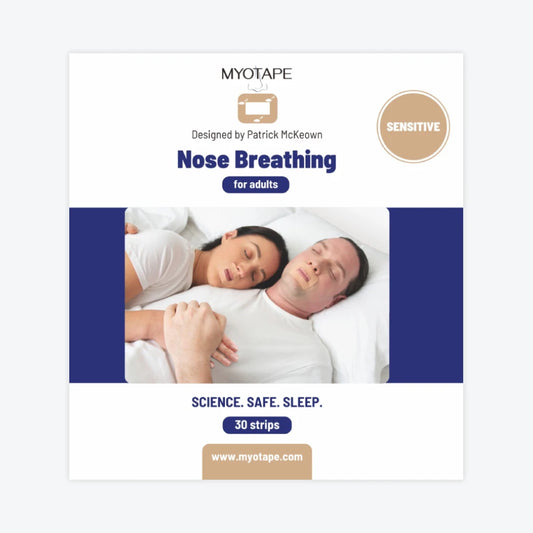Mandibular advancement devices (MAD) are widely used to treat obstructive sleep apnea (OSA). These devices work by increasing the total volume of the upper airway, helping to reduce the number of apnea (complete stoppage of breathing) and hypopnea (partial stoppage of breathing) events during sleep. However, one challenge with MADs is that they can increase mouth breathing, which may reduce their effectiveness.
The Science
A recent study explored how combining an adhesive mouth strip (AMT) with a MAD could improve treatment outcomes for people with OSA (Labarca et al., 2022). The hypothesis was that using a mouth strip to prevent mouth breathing would enhance the efficacy of the MAD by ensuring that the airway remains open throughout the night.
The study included 21 adult participants with an apnea-hypopnea index (AHI) between 10 and 50 events per hour. The AHI measures the severity of sleep apnea by counting the number of apnea and hypopnea events per hour of sleep. Participants were randomized to different treatments: no treatment (baseline), MAD alone, AMT alone, and MAD combined with AMT (MAD + AMT). The primary goal was to compare the AHI between the MAD alone and MAD + AMT groups. Secondary objectives included measuring the percentage change in AHI, the percentage of complete responders (AHI < 5 events per hour), and the efficacy of AMT alone.
Key Findings from the Study
The results showed significant improvements when using both the MAD and AMT together:
- Reduction in AHI: The median AHI for the MAD + AMT group was 5.6 events per hour, compared to 10.5 events per hour for the MAD alone group. This indicates a more effective reduction in apnea and hypopnea events with the combination therapy.
- Higher Success Rates: 76% of participants using MAD + AMT achieved an AHI of less than 10 events per hour, compared to only 43% with MAD alone. This demonstrates a substantial improvement in treatment success.
- Consistency Across Severity Levels: The combination of MAD and AMT was effective even in participants with moderate to severe OSA (AHI ≥ 15 events per hour).
With that, the study concluded that using an adhesive mouth strip in combination with a mandibular advancement device is more effective than using the MAD alone. This combination helps to prevent mouth breathing, ensuring that the upper airway remains open and reducing the number of apnea and hypopnea events.
What Does This Mean?
Mouth breathing can undermine the effectiveness of traditional treatments like mandibular advancement devices (MAD). By incorporating an adhesive mouth strip (AMT) to prevent mouth breathing, patients can experience a significant reduction in apnea and hypopnea events.
This combination therapy not only ensures that the airway remains open throughout the night but also enhances the overall effectiveness of the MAD. In simpler terms, keeping the mouth closed during sleep is crucial for maximizing the benefits of OSA treatments.
MyoTape offers a straightforward and highly effective way to promote nasal breathing and minimize mouth breathing during sleep. Designed by renowed breathing expert, Patrick McKeown, this unique mouth tape helps keep your mouth closed by stimulating the muscles around your mouth, training you to breathe nasally all day, every day. Visit the MyoTape shop to select the right product for you. Available are mouth tapes for kids, for beards, for sensitive skin and for adults.
References:
Labarca G, Sands SA, Cohn V, Demk o G, Vena D, Messineo L, Gell L, Hess L, White DP, Wellman A, Azarbarzin A. Mouth Closing to Improve the Efficacy of Mandibular Advancement Devices in Sleep Apnea. Ann Am Thorac Soc. 2022 Jul;19(7):1185-1192. https://pubmed.ncbi.nlm.nih.gov/35254967/








